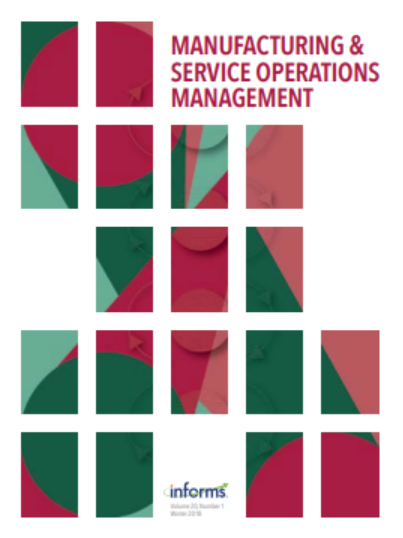检测客户趋势,优化促销目标
IF 4.8
3区 管理学
Q1 MANAGEMENT
M&som-Manufacturing & Service Operations Management
Pub Date : 2023-03-01
DOI:10.1287/msom.2020.0893
引用次数: 6
摘要
问题定义:零售商对个性化产品和服务(如促销)越来越感兴趣。为此,我们需要新的个性化需求模型。不幸的是,由于成本和隐私问题,许多零售商无法获得社交数据。因此,我们关注的问题是从交易数据中检测客户关系,并利用它们向合适的客户进行定向促销。学术/实践相关性:从学术角度出发,本文解决了共同检测客户趋势并利用其进行最优促销定位的新问题。值得注意的是,我们仅从交易数据和多个项目和时间段的目标促销来估计因果客户对客户的趋势效应。在实践中,我们为Oracle Retail客户提供了一种新的工具来个性化促销。方法:我们开发了一种新的客户趋势需求模型,区分基本购买概率(捕获诸如价格和季节性等因素)和客户趋势概率(捕获客户对客户趋势影响)。估计过程是基于正则化有界变量最小二乘和工具变量方法。由此产生的客户趋势估计将输入到动态促销目标优化问题中,该问题被表述为一个非线性混合整数优化模型。虽然这是一个不确定的多项式时间难题,但我们提出了一个贪心算法。结果:我们证明了我们的客户对客户趋势估计在统计上是一致的,并且证明了贪婪优化算法是好的。通过访问Oracle Retail时尚客户数据,我们发现我们的需求模型将加权平均绝对百分比误差平均降低了11%。此外,我们还提供了我们估计的因果关系的证据。最后,我们证明了最优政策使利润增加了3%-11%。管理意义:具有顾客趋势的需求模型和针对性促销的优化模型构成了促销计划的决策支持工具。除了总体规划,它还有助于找到重要的客户,并针对他们产生额外的销售。历史:本文已被接受为2019年制造业&服务营运管理实务研究比赛。资助:这项工作由美国国家科学基金会[Grant CMMI-156334]支持。Oracle公司通过ERO赠款提供的资金也得到了感谢。补充材料:在线附录可在https://doi.org/10.1287/msom.2020.0893上获得。本文章由计算机程序翻译,如有差异,请以英文原文为准。
Detecting Customer Trends for Optimal Promotion Targeting
Problem definition: Retailers have become increasingly interested in personalizing their products and services such as promotions. For this, we need new personalized demand models. Unfortunately, social data are not available to many retailers because of cost and privacy issues. Thus, we focus on the problem of detecting customer relationships from transactional data and using them to target promotions to the right customers. Academic/practical relevance: From an academic point of view, this paper solves the novel problem of jointly detecting customer trends and using them for optimal promotion targeting. Notably, we estimate the causal customer-to-customer trend effect solely from transactional data and target promotions for multiple items and time periods. In practice, we provide a new tool for Oracle Retail clients that personalizes promotions. Methodology: We develop a novel customer trend demand model distinguishing between a base purchase probability, capturing factors such as price and seasonality, and a customer trend probability, capturing customer-to-customer trend effects. The estimation procedure is based on regularized bounded variables least squares and instrumental variable methods. The resulting customer trend estimates feed into the dynamic promotion targeting optimization problem, formulated as a nonlinear mixed-integer optimization model. Though it is nondeterministic polynomial-time hard, we propose a greedy algorithm. Results: We prove that our customer-to-customer trend estimates are statistically consistent and that the greedy optimization algorithm is provably good. Having access to Oracle Retail fashion client data, we show that our demand model reduces the weighted-mean absolute percentage error by 11% on average. Also, we provide evidence of the causality of our estimates. Finally, we demonstrate that the optimal policy increases profits by 3%–11%. Managerial implications: The demand model with customer trend and the optimization model for targeted promotions form a decision-support tool for promotion planning. Next to general planning, it also helps to find important customers and target them to generate additional sales. History: This paper has been accepted as part of the 2019 Manufacturing & Service Operations Management Practice-Based Research Competition. Funding: This work was supported by the U.S. National Science Foundation [Grant CMMI-156334]. Funding from the Oracle Corporation through an ERO grant is also gratefully acknowledged. Supplemental Material: The online appendices are available at https://doi.org/10.1287/msom.2020.0893 .
求助全文
通过发布文献求助,成功后即可免费获取论文全文。
去求助
来源期刊

M&som-Manufacturing & Service Operations Management
管理科学-运筹学与管理科学
CiteScore
9.30
自引率
12.70%
发文量
184
审稿时长
12 months
期刊介绍:
M&SOM is the INFORMS journal for operations management. The purpose of the journal is to publish high-impact manuscripts that report relevant research on important problems in operations management (OM). The field of OM is the study of the innovative or traditional processes for the design, procurement, production, delivery, and recovery of goods and services. OM research entails the control, planning, design, and improvement of these processes. This research can be prescriptive, descriptive, or predictive; however, the intent of the research is ultimately to develop some form of enduring knowledge that can lead to more efficient or effective processes for the creation and delivery of goods and services.
M&SOM encourages a variety of methodological approaches to OM research; papers may be theoretical or empirical, analytical or computational, and may be based on a range of established research disciplines. M&SOM encourages contributions in OM across the full spectrum of decision making: strategic, tactical, and operational. Furthermore, the journal supports research that examines pertinent issues at the interfaces between OM and other functional areas.
 求助内容:
求助内容: 应助结果提醒方式:
应助结果提醒方式:


